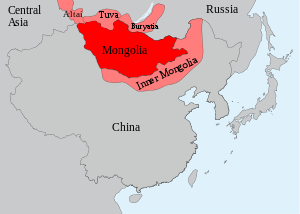|
Inner Mongolian independence movement
  The Inner Mongolian independence movement (Chinese: 内蒙古独立运动), also known as the Southern Mongolian independence movement (Chinese: 南蒙古独立运动), is a movement for the independence of Inner Mongolia (also known as Southern Mongolia[1]) and the political separation of Inner Mongolia from the People's Republic of China.[2] It is principally led by the Mongolian diaspora in countries like Japan and the United States, and in some European countries.[3] The movement is led primarily by three popular organizations: the Inner Mongolian People's Party, a member of the Unrepresented Nations and Peoples Organization; the Southern Mongolian Democratic Alliance,[4] and the Mongolian Liberal Union Party,[5] led by Temtsiltu Shobtsood (Xi Haiming), the Southern Mongolian Democratic Alliance, led by Hada; and the Mongolian Liberal Union Party, led by Olhunud Daichin.[citation needed] The stated goals of all three organizations are the secession of Inner Mongolia from the People's Republic of China, and either the establishment of an independent Inner Mongolian state or the unification of Inner Mongolia with "Outer Mongolia", i.e. the State of Mongolia.[6] The Chinese government asserts that there is active Inner Mongolian separatism, and the 2020 Inner Mongolia protests and a few other specific examples have been noted.[7] In 2018, Chinese state media outlet Economic Daily reported that a man surnamed Jiang was the first in Inner Mongolia to be sentenced on charges of terrorism in the region, although it was not specified what cause he was supporting.[8] See also
References
|
